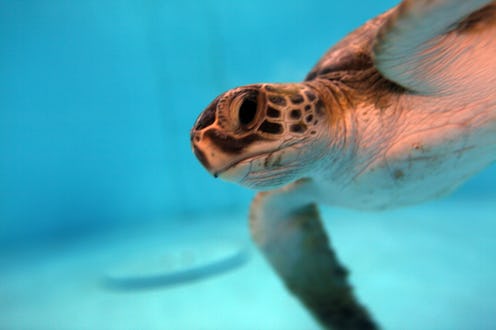Life
Over 99 Percent Of These Baby Sea Turtles Were Born Female Because Of Climate Change

Climate change was a hot topic in 2017 (pun not intended), and is bound to be a huge topic of discussion throughout 2018. Despite the current administrations' comments about global warming, the majority of scientists have asserted that climate change is very real. From the Great Barrier Reef to the Amazon Rainforest, the detrimental effects of climate change have been documented across the planet. Now, most recently, scientists are reporting the effects on sea turtles, and it’s not good: Over 99 percent of baby sea turtles in Northern Australia were born female because of climate change.
According to the study, which was published on Jan. 8 in the journal Current Biology, global warming is having a detrimental effect on green sea turtle populations (yes, like Crush from Finding Nemo), and the sex of their offspring. The researchers conducted their study right off the coast of Australia, in the Northern Great Barrier Reef area — a large breeding ground for this species of sea turtle. After examining the sex and blood tests of young green sea turtles, the scientists determined that 99.1 percent of “juvenile” green sea turtles in this region were female, while 86.8 percent of adult turtles were also female. The study revealed the ever-so-slight increase in global temperatures and climate change is to blame for predominantly female hatching in this area for over two decades.
“With warming global temperatures and most sea turtle populations naturally producing offspring above the pivotal temperature, it is clear that climate change poses a serious threat to the persistence of these populations,” the study reads. “The process of natural selection takes place over the course of many generations, and for a long-lived species like sea turtles, such changes are likely to require centuries. With temperatures predicted to increase by several degrees in only a few turtle generations, many sea turtle populations...will have little room to adapt to a rapidly changing climate.”
Temperature plays a large role in green sea turtles mating season. Green sea turtles' sex is determined during fertilization by the temperature of the sand where the eggs are hatched. The difference between a hatchling being born a female versus a male is just a few, slight degrees — 85 degrees Fahrenheit (aka, 30 degrees Celsius) or above usually leads to predominantly female baby turtles, while temperatures below this lead to predominantly male hatchlings. With over 99 percent of the green sea turtle population in the northern Great Barrier Reef region being born female, it is a very real possibility the species is facing a steep decline in population.
Moreover, the researchers discovered that climate change is not only causing a disproportionate amount of female hatchlings, but that the extreme temperatures are also causing high mortality rates among developing eggs. The scientists urged in their study that “immediate management strategies” need to be implemented to lower the incubation temperatures for sea turtles to avoid not only declining populations, but complete extinction. Green sea turtles’ conservation status is currently listed as endangered: In addition to the threats posed by global warming, green sea turtle populations are at risk of extinction due to getting caught in fishing lines or nets, ocean pollution, beach erosion, and even being hunted as adults.
Green sea turtles play a crucial role in beach ecosystems, and are key to maintaining healthy marine life. According to the Sea Turtle Conservatory, sea turtle nesting areas help spur vegetation in beach and dune areas, which in turns provides nutrients to other species of wildlife and the environment itself. Furthermore, much like cows, green sea turtles graze on seagrass beds, and keep the oceanic grass healthy for thousands of other species that call it home. If sea turtles went extinct, there would be a lofty (and devastating) environmental impact: Beaches would actually begin to wash away from a lack of nutrients, and animals that sea turtles eat, like jellyfish, would cause chaos around fisheries and recreational areas.
Organizations across the globe are making large efforts to save green sea turtle populations, and the six other species of sea turtles. The World Wildlife Fund’s (WWF) is attempting to save green sea turtle populations by helping fisheries switch to turtle-friendly fish hooks, satellite tracking the migration patterns of the turtles, and is establishing marine protected areas (MPA) to ensure green sea turtle’s have a safe place to nest. Additionally, the Raine Island Recovery Project is a large collaboration effort between the Queensland government and conservation groups to restore and protect the breeding of green sea turtles on this island off the coast of Northern Australia.
A few degrees may not seem like a noticeable difference to you or me, but a slight change in the temperature can wreak havoc on wildlife species worldwide, and entire ecosystems. The survival of future populations of green sea turtles depend on our conservation efforts, and our efforts to stop global warming before it gets worse.